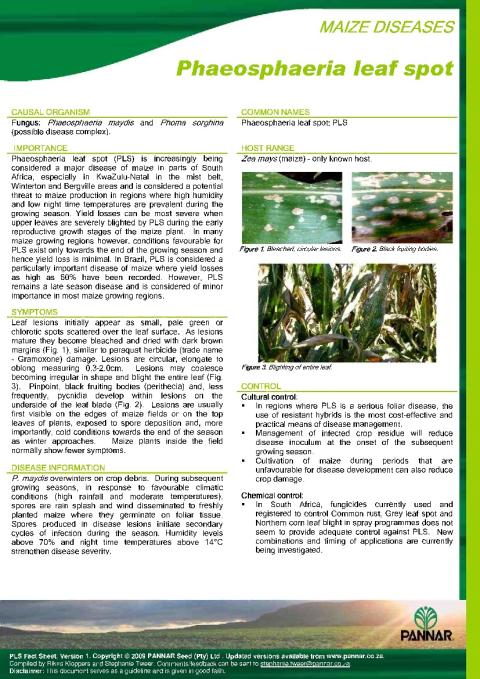MAIZE DISEASES
Phaeosphaeria leaf spot
CAUSAL ORGANISM
Fungus: Phaeosphaeria maydis and Phoma sorghina
(possible disease complex).
I MPORTANC.
Phaeosphaeria leaf spot (PLS)
isincreasingly being
considered a major disease of maize in parts of South
Africa, especially inKwaZulu-Natal inthe mist belt,
Winterton and Bergville areas and is considered a potential
threat to maize production in regions where high humidity and low night time temperatures are prevalent during the
growing season. Yield losses can be most severe when upper leaves are severely blighted by PLS during the early
reproductive growth stages of the maize plant. In many
maize growing regions however, conditions favourable for
PLS exist only towards the end of the growing season and
hence yield loss is minimal. In Brazil, PLS is considered a
particularly important disease of maize where yield losses
as high as 60% have been recorded. However, PLS
remains a late season disease and is considered of minor
importance in most maize growing regions.
SYMPTOMS
Leaf lesions initiallyappear as small,
pale green or
chlorotic spots scattered over the leaf surface. As lesions mature they become bleached and dried with dark brown
margins (Fig. 1), similar to paraquat herbicide (trade name
- Gramoxone) damage. Lesions are circular, elongate to
oblong measuring 0.3-2.0cm. Lesions may coalesce
becoming irregular in shape and blight the entire leaf (Fig.
3). Pinpoint, black fruiting bodies (perithecia) and, less
frequently, pycnidiadevelopwithinlesions onthe
underside of the leaf blade (Fig. 2). Lesions are usually
first visible on the edges of maize fields or on the top
leaves of plants, exposed to spore deposition and, more
importantly, cold conditions towards the end of the season
as winter approaches. Maize plants inside the field
normally show fewer symptoms.
DISEASE INFORMATION
P. maydis overwinters on crop debris. During subsequent
growing seasons, inresponse tofavourable climatic
conditions (highrainfall and moderate temperatures),
spores are rain splash and wind disseminated to freshly planted maize where they germinate on foliar tissue.
Spores produced in disease lesions initiate secondary
cycles of infection during the season. Humidity levels
above 70% and night time temperatures above 14°C
strenathen disease severity. COMMON NAMES
Phaeosphaeria leaf spot; PLS
HOST RANGE
Zea mays (maize) - only known host.
Figure 1. Bleached, circular lesions. Figure 2 Black fruiting bodies.
Figure 3. Blighting of entire leaf
CONTROL
Cultural control: In regions where PLS is a serious foliar disease, the
use of resistant hybrids is the most cost-effective and
practical means of disease management.
Management of infected crop residue
willreduce
disease inoculum at the onset of the subsequent
growing season. Cultivation ofmaize during periods
thatare
unfavourable for disease development can also reduce
crop damage.
Chemical control: InSouth Africa, fungicides currently
usedand
registered to control Common rust, Grey leaf spot and
Northern corn leaf blight in spray programmes does not
seem to provide adequate control against PLS. New
combinations and timing of applications are currently
being investigated.
PANNAR
PLS Fact Sheet, Version 1. Copyright © 2009 PANNAR Seed (Pty) Ltd . Updated versions available from www.pannar.co.za.
Compiled by Rikus Kloppers and Stephanie Tweer. Comments/feedback can be sent to stephanie.tweergpannar.co.za.
Disclaimer: This document serves as a guideline and is given in good faith.
This resource originates from http://www.plantwise.org…. Click on this link to download from the source. If the original link doesn´t work, click on the image in the box on the right and download a copy.

